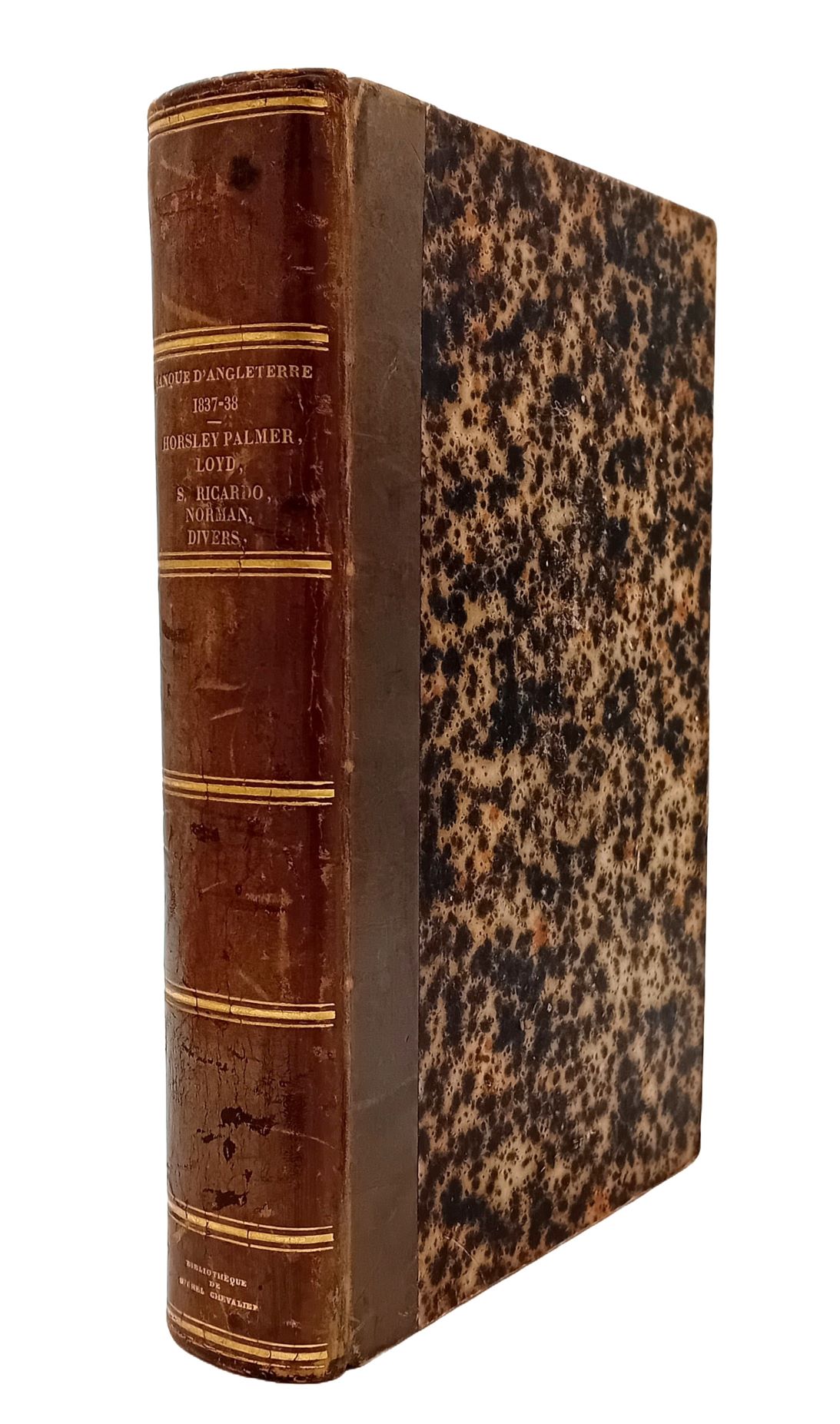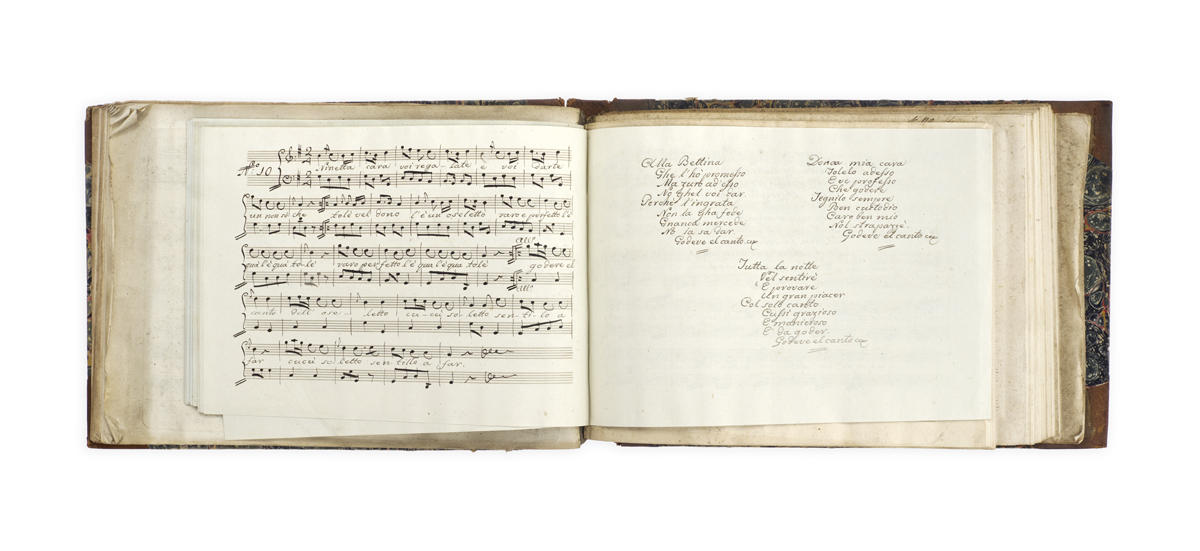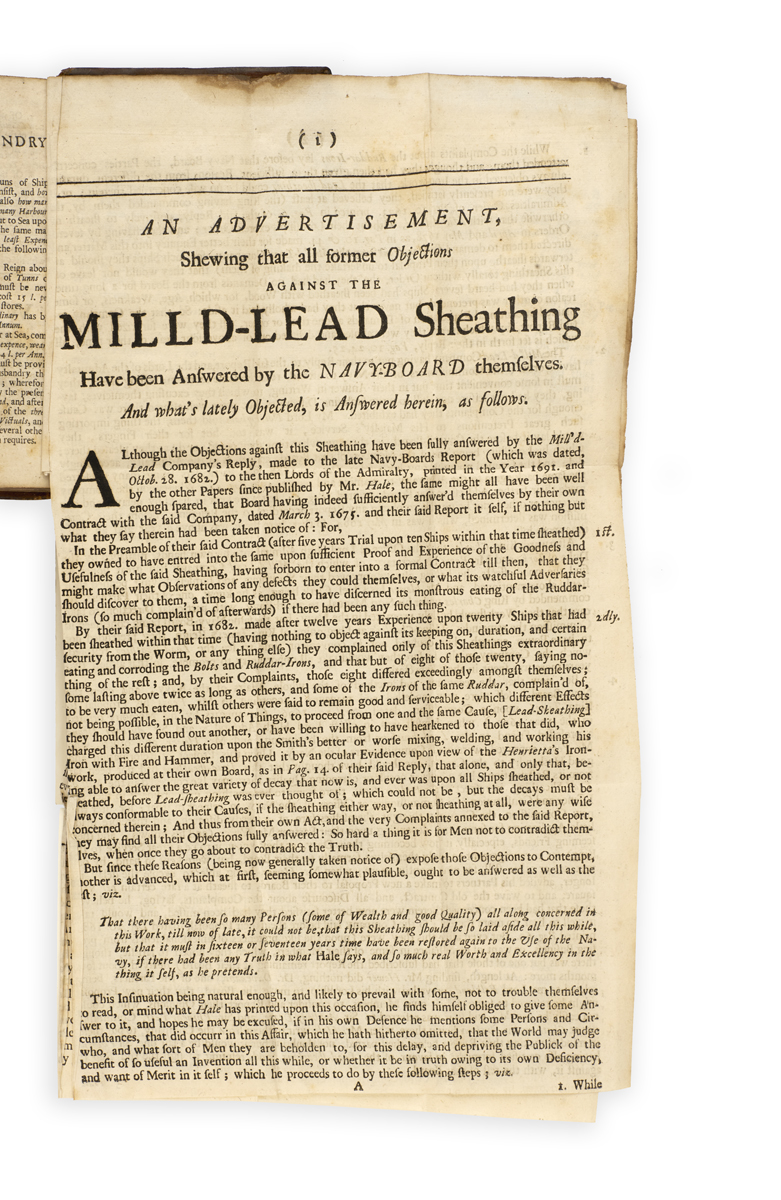


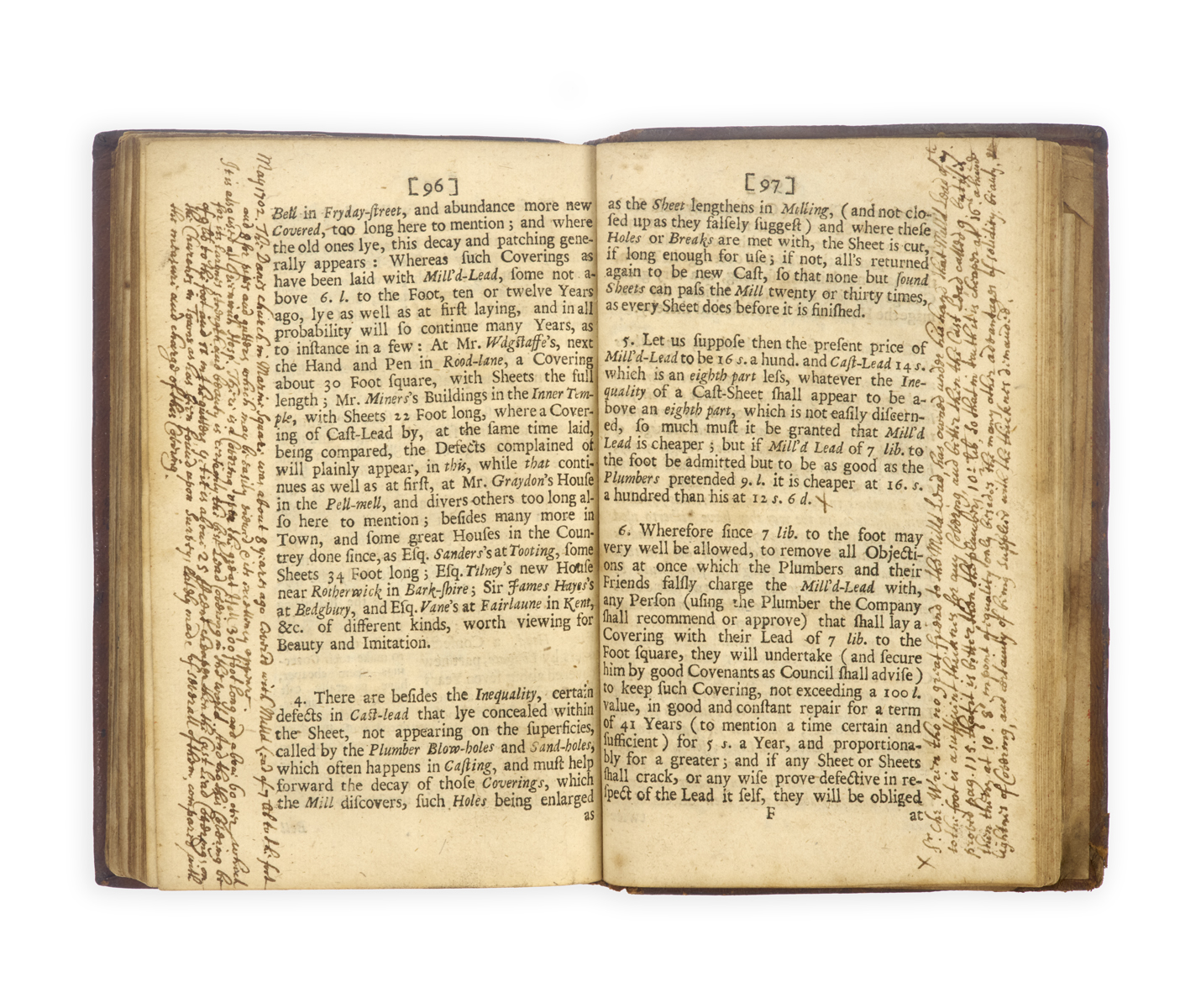
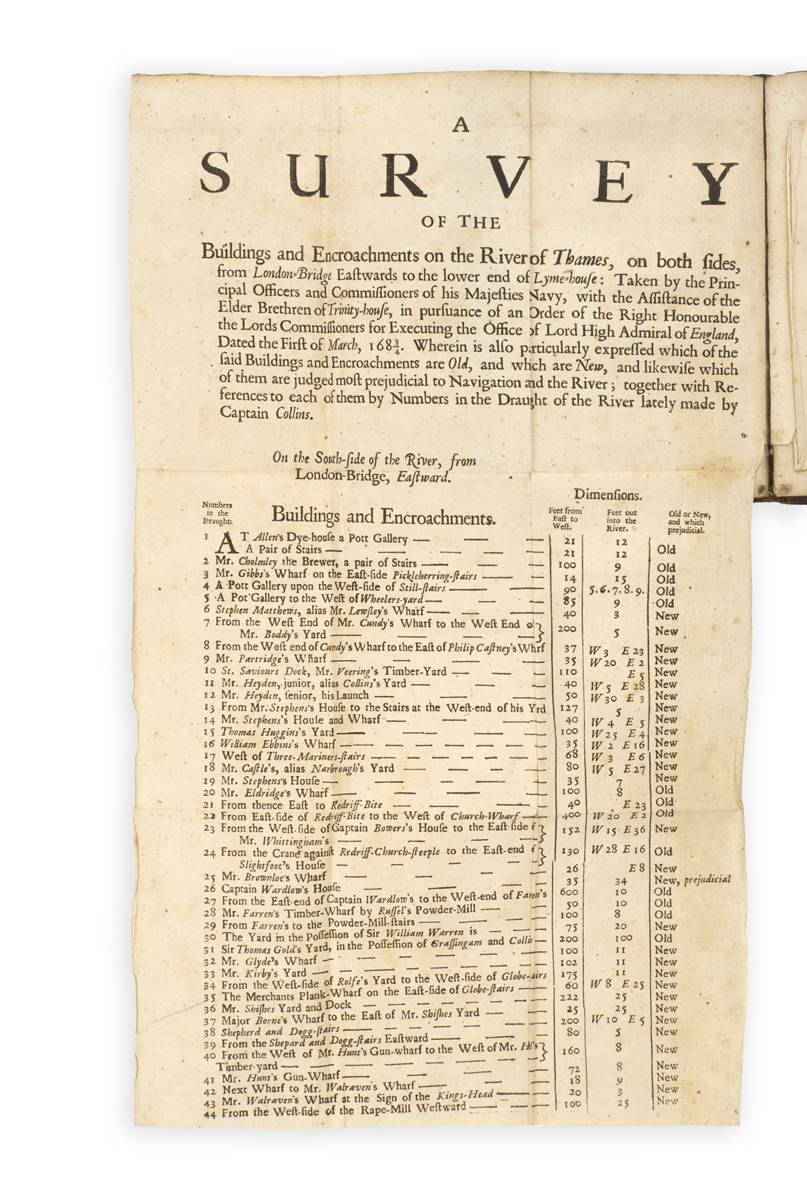
LEAD ON SHIPS, AND THEN ON ROOFS
[HALE, Thomas, Sir William PETTY, and Samuel PEPYS?].
An Account of several new Inventions and Improvements now necessary for England, in a Discourse by Way of a Letter to the Earl of Marlborough, relating to Building of English Shipping, Planting of Oaken Timber in the Forrests … [etc.] Herewith is also published at large the Proceedings relating to the Mill’d-Lead-sheathing, and the Excellency and cheapness of Mill’d-Lead in preference to cast Sheet-Lead for all other purposes whatsoever. Also a Treatise of Naval Philosophy, written by Sir Will. Petty …
London, Printed for James Atwood, and are to be sold by Ralph Simpson … 1691.
[bound with:]
A Survey of the Buildings and Encroachments on the River Thames … [1691?]
[and with:]
That the bringing on Boards above, and Paying the Plank with Stuff under a mill’d-lead-sheathing, is damageable, more charge, and altogether unnecessary; plainly prov’d from Experience as well as Reason … [London, ‘may be had at Mr Nelme’s … and at Mr Basset’s’, October 1697.]
[and with:]
An Advertisement shewing that all former Objections against the Milld-lead Sheathing have been answered by the Navy-board themselves … London, Printed May, 1696.
12mo, pp. [12], cxxv, [19], 132; The New Invention of Mill’d Lead has a separate title-page and pagination, register continuous; with the Survey (folio, two leaves), and That the bringing on Boards etc. (folio broadside), folded and bound before B1; the Advertisement (folio, pp. 4), folded and bound at the end; short worm-track touching the odd letter, else a fine copy, in contemporary speckled sheep, covers tooled in blind; authorial manuscript additions to the margins of p. 33, 96–7, and 116, and to That the bringing on Boards etc., and a few scattered corrections; armorial bookplate to title verso of James Hustler of Acklam, dated 1730.

Added to your basket:
An Account of several new Inventions and Improvements now necessary for England, in a Discourse by Way of a Letter to the Earl of Marlborough, relating to Building of English Shipping, Planting of Oaken Timber in the Forrests … [etc.] Herewith is also published at large the Proceedings relating to the Mill’d-Lead-sheathing, and the Excellency and cheapness of Mill’d-Lead in preference to cast Sheet-Lead for all other purposes whatsoever. Also a Treatise of Naval Philosophy, written by Sir Will. Petty …
First edition of Hale’s Account with several rare broadsides on the same topic – the use of milled lead (rather than cast lead, or even wood) for the sheathing of ships as a defence against worm. Thomas Hale operated a lead mill in Deptford (his brother? Charles was a leadworker) and was a director of the Milled Lead Company, which had been founded by Sir Philip Howard and Francis Watson in 1670 with a 20-year patent, taking over sole interest in 1690. The manuscript additions in this copy, almost certainly authorial, add corroborating information up to 1702: milled lead, Hale writes, has been used on the roof of St Clement Dane’s and Greenwich Hospital, and even Christopher Wren, ‘tho no great friend to the Milld Lead, has owned under his hand’ that it is better and cheaper than cast lead.
After a first successful test on the Phoenix in 1671–3, Charles II had ordered all ships to be sheathed in lead and around twenty ships were so sheathed; but then allegations emerged that it caused rapid corrosion of the ironwork (though it was to be another century until the scientific reason for the corrosion was discovered). A commission to investigate was set up in 1682 and the use of milled lead on ships largely abandoned. The New Invention of Mill’d Lead opens with Howard and Watson’s reply to the 1682 commission – they accused the navy of using low quality iron – and a further memorial of 1686, and adds testimonials to its effectiveness by various master-builders, as well as a reprint of an Advertisement to all who have occasion to make use of sheet lead (1690) by Hale. At the front of the work is a long and rambling letter to the Earl of Marlborough (pp. cxxv), which mentions lead only briefly and takes in Tycho Brahe, calendar reform, land tax, Peter Pett’s Happy future state of England (1688), lighthouses, the New River Company, and encroachments on the river Thames that impede passage. The shipwright Phineas Pett II, a supporter of Hale, is referred to several times, with special praise for his ship Britannia, of which an ‘admirable draught of sculpture … in four large sheets of Dutch paper’ is announced (untraced). Hale also mentions several works by Sir William Petty seen in manuscript. Petty had been appointed a commissioner of the Navy in 1681, and a ‘Treatise on Naval Philosophy’ is printed under his name here (pp. 117–132).
The two additional folio publications bound in here are very scarce. The first, which accuses shipwrights of subterfuge in the fitting of sheathing, is known in two issues at three locations only (BL, NLS, and Huntingon); the Advertisement (BL, NLS, and Yale only) contains a summary of the history of the Milled Lead Company, mentioning Pepys frequently. Hale suggests that Pepys was long a support of milled lead and was in fact the author of the ‘Reply to the Navy Board’ that Hale printed in his Account, but that he changed his position to follow ‘another Interest’. The naval use of milled lead having been abandoned, Hale now advertises it for use in roofing.
Wing H265 (with S6198); H266A; H219.
